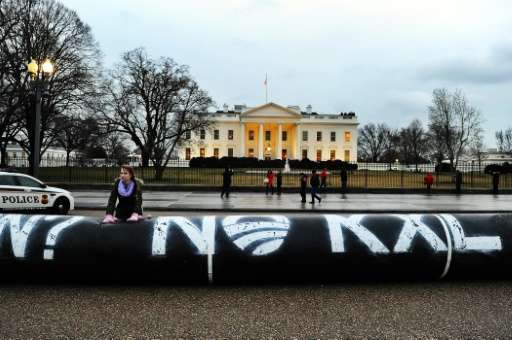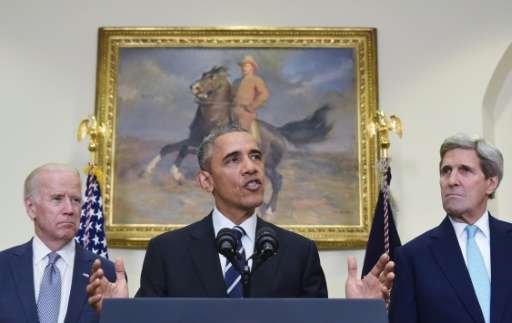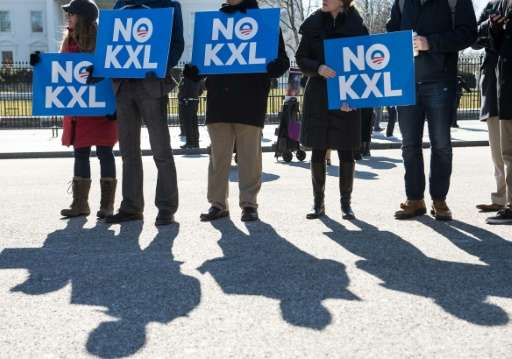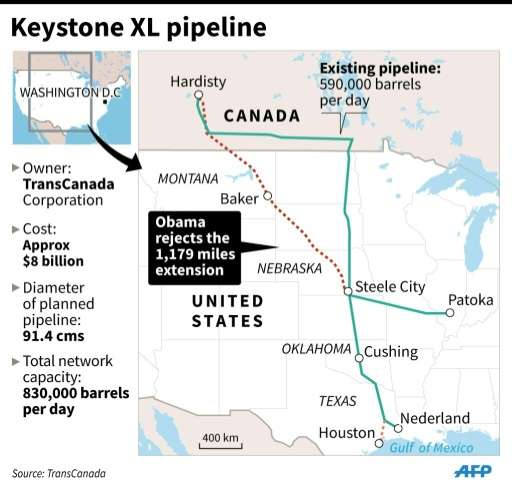Environmental activists during a demonstration in front of the White House in Washington, DC to protest against the Keystone pipeline project, on February 3, 2014
US President Barack Obama blocked the construction of a controversial Keystone XL oil pipeline between Canada and the United States Friday following years of bitter and politically charged debate.
His Republican opponents vowed to revive the project, which they say is critical to the nation's energy independence and will provide much-needed jobs.
Critics, however, have warned of an unjustifiably heavy environmental impact and that the economic benefits would be limited because all but a handful of the jobs it generates would disappear when the two-year construction project was complete.
Here are key facts about the project.
What was it?
Keystone XL was an expansion of TransCanada's existing system to funnel oil from Alberta's tar sands to refineries in the United States.
The initial $7 billion proposal in 2008 was to build a pipeline from Hardisty, Alberta that would cut through Montana to meet up with TransCanada's existing line in Steele City, Nebraska—and then add on a new southern leg to bring the oil to Texas refineries.
After years of delays, TransCanada separated the southern portion into a project that did not require presidential approval and the Gulf Coast pipeline began delivering oil from Oklahoma to Texas in January 2014.
US President Barack Obama speaks on the Keystone XL pipeline, flanked by Secretary of State John Kerry (R), and Vice President Joe Biden, on November 6, 2015 in the Roosevelt Room of the White House in Washington, DC
What remained was a $5.3 billion proposal to build a 1,179-mile (1,900 kilometer) pipeline from Alberta to Nebraska.
Why is it so controversial?
Alberta's tar sands are considered to have the 'dirtiest' oil on the planet. Unlike traditional crude which gushes from a well, tar sand oil must be dug up and essentially melted with steaming hot water before it can be refined.
This means more fossil fuels need to be burned as part of the extraction process, which further contributes to climate change. It also results in huge lakes of polluted water and the strip-mining of millions of acres of once-pristine boreal forests.
Environmentalists argue tar sand oil contains a harmful and corrosive component—bitumen—which makes pipeline ruptures or leaks more likely and carries greater health and safety risks.
There was also significant opposition to the initial route, since changed, because it passed through Nebraska's environmentally sensitive Sand Hills grasslands and over a huge, critical aquifer that serves eight US states.
Demonstrators hold signs against the proposed Keystone XL pipeline from Canada to the Gulf of Mexico in front of the White House in Washington, DC on January 28, 2015
Economic Impact
The proposal was welcome news to a nation suffering from the 2008 financial crisis. The State Department estimated the new, shorter route would have created 42,000 temporary jobs over the two-year construction period. Opponents noted that just 35 permanent jobs would be created for pipeline maintenance and argued that the project will kill more jobs than it creates by diverting investment away from more labor-intensive green energy alternatives like wind and solar power.
Energy Security
"Drill baby, drill" was a common chant at Republican political rallies ahead of the 2008 election, and many Americans still do not believe climate change is a reality. TransCanada argues that bringing another 830,000 barrels of oil a day from friendly, neighboring Canada would reduce US dependence on the Middle East and Venezuela by up to 40 percent.
Opponents argue that Keystone will have no impact on the nation's energy security because much of the oil will be shipped to refineries in tax-free foreign trade zones and then exported.
The Keystone pipeline
Safety
TransCanada argued that buried pipelines are far safer for transporting oil than ships or trains and claims to have "one of the best safety records in the industry." It also notes that there are more than 2.6 million miles of oil and gas pipelines in the United States "that deliver 99.9998 percent of their products safely and reliably every day."
The pipeline would have been equipped with 21,000 sensors that provide updates every five seconds via satellite and the ability to isolate a problem within minutes through remote-controlled valves. Critics note the existing Keystone pipeline developed a dozen leaks in its first year of operation.
© 2015 AFP



























